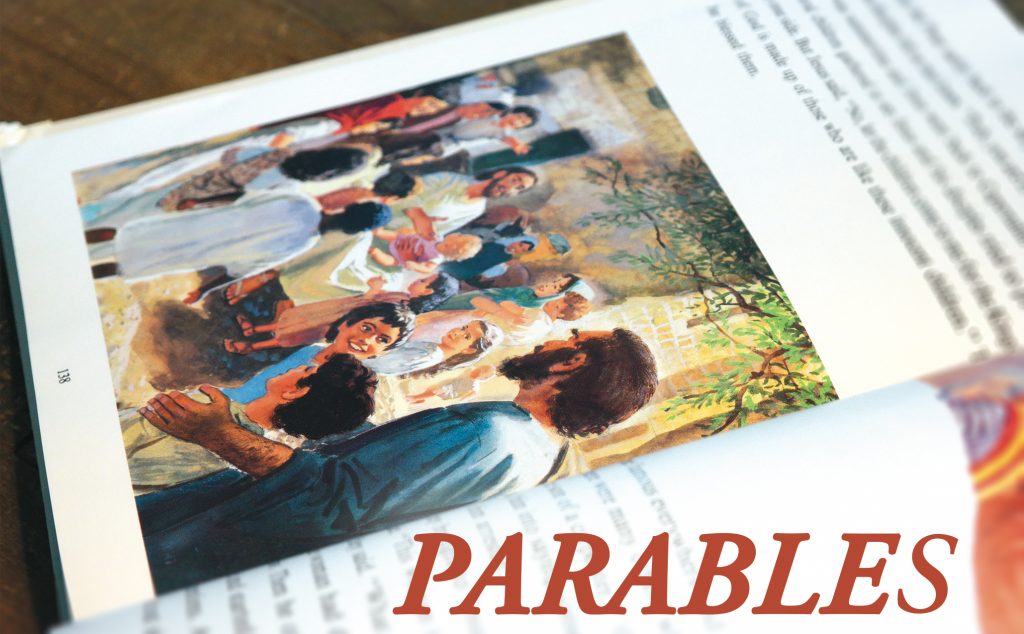Parables

by Stephen Chambers
Everyone loves a mystery, they say. That might be why Jesus’ parables are so popular. They use ordinary language to point toward spiritual realities which transcend our everyday experience, and the gaps between those two worlds are both fascinating and mysterious. “What is the point of that parable?” we ask as we read it. And we’re in good company as we ask that question. Uncertainty about the meaning of these puzzling little stories was common among Jesus’ original disciples, too, as the Gospels make clear (Matthew 13:36; Mark 4:10; Luke 12:41).
In this sense, it might help to think of a parable as “an earthly story with a heavenly meaning.”
It’s even hard to decide how many parables Jesus told. The Lutheran Study Bible, for instance, provides a list of 55 parabolic sayings, while Concordia Self-Study Bible includes only 40. Some of this difference is because the longer list divides up material that the shorter list groups together. For example, does Luke 14:28-33 include one parable or two? Interestingly, though, the shorter list includes Jesus’ saying about the lamp under the bowl (Matthew 5:14-15) which the longer list does not consider to be a parable. The reasons for such differences of opinion can themselves be a bit of a mystery!

Part of the problem is ambiguity about how to define the term parable itself. The Greek word parabole simply refers to a comparison between two things that are set alongside each other. Such comparisons take many forms, including illustrations, proverbs, maxims, and various kinds of figurative speech. Thankfully, the word “parable” is explicitly attached to quite a few of our Lord’s sayings, in many cases by Jesus Himself. It’s clear in those cases that we are in fact dealing with parabolic material. However, in Luke 6:39, the Evangelist calls something a parable that we might otherwise think of simply as descriptive speech. In Luke 12:41, Peter does the same. Complicating the situation still more is the fact that John’s Gospel never uses the word “parable” and does not include any of the comparative stories that most people call by that name. John does, however, use the related term paroimia, meaning “a veiled saying,” to refer to some of Jesus’ teachings (for example, John 16:25). This is why Jesus’ great “I am” sayings in the Gospel of John—including the “Good Shepherd” material in John 10—are sometimes considered to be parables, in an extended sense.
Because they are essentially comparisons, interpreting parables is simple—at least in theory. The goal is to find the point of comparison between the everyday story Jesus is telling on the surface, and the spiritual truth He is proclaiming more deeply. In this sense, it might help to think of a parable as “an earthly story with a heavenly meaning.”
The goal is to find the point of comparison between the everyday story Jesus is telling on the surface, and the spiritual truth He is proclaiming more deeply. In this sense, it might help to think of a parable as “an earthly story with a heavenly meaning.”
Even so, parables remain mysterious, because the number of places at which a heavenly meaning can be discerned varies considerably from story to story. In the parable of the weeds, for instance, Jesus connects at least seven of the story’s details to spiritual realities (Matthew 13:37-39). More typically, Jesus explains the parable of the sower by identifying three points of comparison: the seed is the Word of God, the different soils into which it falls represent the diverse ways that Word is received, and the variable harvest is an indication of the Word’s differing degrees of fruitfulness (Matthew 13:18-23 and parallels). Meanwhile, Luke introduces the parable of the unjust judge by indicating just one point of comparison: “we ought always to pray and not lose heart” (Luke 18:1).
Occasionally, as in the parable of the tax collector and the Pharisee, we’re told what to look for in a more general way: “Jesus told this parable to some who trusted in themselves that they were righteous and treated others with contempt” (Luke 18:9). And many parables, of course, do not give us any guidance at all about how many points we ought to look for. This includes not only very short parables, such as the treasure hidden in the field (Matthew 13:44), but also one of the longest parables of them all, the story known as either “the prodigal son” or “the waiting father” (Luke 15:11-32).
Despite the uncertainty about how many points of comparison we should look for, we can safely assume there’s always at least one. And most of the time, that comparison focuses on the Kingdom of God (or, as Matthew calls it, the Kingdom of Heaven). In Matthew 13, for instance, we find seven parables in a row that include variations on the phrase, “The Kingdom of Heaven is like…” This does not mean of course that all of Jesus’ parables deal with this subject: quite a few focus on the theme of judgement, including well-known examples such as the wedding feast (Matthew 22:1-14) and the fig tree (Matthew 24:32-34 and parallels). As a starting-place, though, it’s often a good idea to approach a parable by asking what it might be telling us about the Kingdom of God. Very often, the points of comparison will be both obvious and illuminating, whether or not the Gospels reveal them to us explicitly (as in the sheep and the goats, Matthew 25:31-46) or leave it up to us to figure them out (as in the parable of the great banquet, Luke 14:15-24).
As simple as they seem on the surface, they often conceal as much as they reveal.
Many of the parables of the Kingdom rely on standard motifs that are drawn from the Old Testament. Stories about vineyards, for example, echo passages that portray Israel as God’s vineyard, such as Isaiah 5:1-7 and Ezekiel 17:1-8 (which, interestingly, is called a mashal—the Hebrew equivalent of “parable”). Kings stand-in for God (Psalm 9:7-8, 47:6-7), while servants represent His people (Isaiah 41:8-9, 54:17). Feasts point ahead to the rich fullness of the End, when God Himself will dine with His people (Isaiah 25:6-9, 55:1-2). The fact that images like these are so common in Jesus’ parables, and so closely linked to the Old Testament, not only makes parables easier to figure out but also provides a certain degree of control over their interpretation.
The context in which we find a particular parable in the Gospels can also be a helpful key to its meaning. For example, the fact that the parable of the mustard seed is tightly tied to the parable of the leaven in all three of the places we find it, shows that its main point is the contrast between the tiny size of God’s Kingdom when it first appears and the great size it finally grows into (Matthew 13:31-32, Mark 4:30-32, Luke 13:18-19). Likewise, that the parable of the rich fool appears in the middle of several conversations about wealth reinforces the fact that it too wants to teach us how to be “rich toward God” (Luke 12:16-21).

Finally, it’s important to remember that Jesus’ parables grew out of His first-century context and spoke, first of all, to His original Palestinian hearers. For this reason, many of their nuances can elude modern Canadian readers. We might assume, for instance, that most of Jesus’ hearers would be in a position to get married, buy livestock, and give a banquet (Luke 14:16-21). In reality, most of them were more like the poor people who were usually excluded from such activities but, in this instance, were astonished to find themselves invited to take part in such a lavish banquet, as a gift (see Luke 14:13-15, 21). The question is, who does Jesus intend us to identify with more closely: the banquet-giver or the gift-receiver? The point of the story differs greatly, depending on our answer.
Many of the parables of the Kingdom rely on standard motifs that are drawn from the Old Testament. Stories about vineyards, for example, echo passages that portray Israel as God’s vineyard, such as Isaiah 5:1-7 and Ezekiel 17:1-8 (which, interestingly, is called a mashal—the Hebrew equivalent of “parable”).
For all of these reasons, it’s an excellent idea to keep a good study Bible or commentary handy when we’re reading Jesus’ parables. As simple as they seem on the surface, they often conceal as much as they reveal. That, of course, is exactly what Jesus told His first disciples when they asked Him why He taught in this way. “To you,” He said, “it has been given to know the secrets (literally, mysteria) of the Kingdom of God. But for others they are in parables, so that seeing they may not see, and hearing they may not understand” (Luke 8:9-10).
The reality is that no story drawn from life in this world can prepare us for the unfathomable way God’s Kingdom breaks into this world as He Himself sows the seed of His Word. As the Lord Himself puts it in Isaiah, “Forget the former things; do not dwell on the past. See, I am doing a new thing! Now it springs up: do you not perceive it?” (Isaiah 42:18-19) That new thing is, ultimately, the inbreaking of His Kingdom, through Jesus’ life, death, and resurrection.
In His parables, Jesus points us toward the Kingdom of God and gives us scattered and partial glimpses of what it looks like. Through His cross and empty tomb, we see more clearly what that Kingdom is—and what it cost. But it is only when He comes again that the curtain will finally be drawn all the way back, so we can see it face to face and know it fully (1 Corinthians 13:12).
———————
Rev. Dr. Stephen Chambers is associate pastor of Grace Lutheran Church (Edmonton, Alberta).




